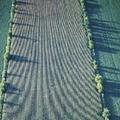This is the VOA Special English Agriculture Report.
Farmers use different kinds of soil conservation methods to protect their land from damage by farming and the forces of nature. One important form of soil conservation is the use of windbreaks.
Windbreaks are barriers formed by trees and other plants. Farmers plant these barriers around their fields.
Windbreaks stop the wind from blowing soil away. They also keep the wind from destroying or damaging crops. They are very important for protecting grain crops.
There have been studies done on windbreaks in parts of West Africa, for example. These found that grain harvests can be twenty percent higher in fields protected by windbreaks compared to fields without such protection.
But windbreaks seem to work best when they allow some winds to pass through them. If the wall of trees and plants blocks the wind completely, then violent air motions will take place close to the ground. These motions will lift soil into the air where it will be blown away.
For this reason, a windbreak is best if it has only sixty to eighty percent of the trees and plants needed to make a solid line. An easy rule to remember is that windbreaks can protect areas up to ten times the height of the tallest trees in the windbreak.
There should be at least two lines in each windbreak. One line should be large trees. The second line, right next to it, can be shorter trees and other plants with leaves. Locally grown trees and plants are best for windbreaks.
If the quality of the land is not very good, studies have shown that one kind of tree that can grow well is the white pine. Another is the loblolly pine.
Windbreaks not only protect land and crops from the wind. Surplus trees can be cut down and used to provide wood.
Trees reduce the damaging effects of wind and rain. Their roots help protect soil from being washed away. And trees do something else -- they can provide grazing animals with shade from the sun.
And that's the VOA Special Agriculture Report. You can get more information about windbreaks and other forms of soil conservation at enterpriseworks.org. And you can also learn more about agriculture at our Web site, voaspecialenglish.com. I'm Jim Tedder.

